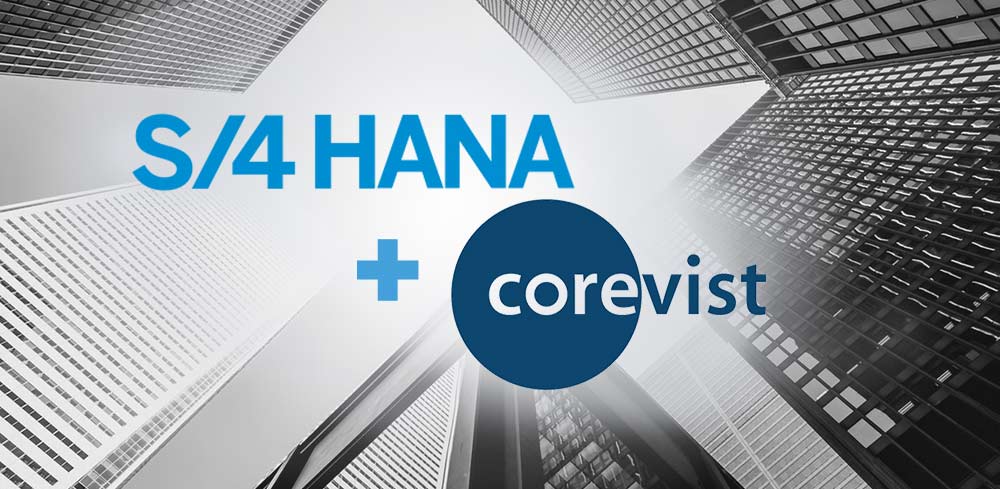Share
Author
George Anderson
Share
S/4HANA plus integrated eCommerce
With SAP ECC 6.0 reaching end-of-life in 2025, manufacturers are making plans for the continuity of their ERP systems. Companies on ECC have two high-level options:
- Migrate to S/4HANA
- Extend ECC support through a 3rd party
Every IT executive must make their own decision, but generally, we recommend migrating to S/4HANA. In addition to all the value which S/4HANA offers as an ERP system, it also creates a whole new ballgame in terms of eCommerce integration.
1. Corevist Commerce loads fast when integrated to S/4HANA
There’s no inherent reason why an SAP ECC system should be slow, but we’ve worked with enough client systems over the years to know that ECC systems do get bogged down. They accrue layers of customization as IT teams come and go. At Corevist, we work with every ECC client to help clean up their ERP system and improve performance—which not only boosts the speed of Corevist Commerce, but ripples out into the rest of the organization, as everyone who accesses the ERP gets better performance.
It’s rare that we encounter a client whose ECC performance becomes a real issue for their Corevist user experience. However, in these rare cases, we’ve recommended Meister for ERP performance enhancement.
Because it’s designed to keep frequently-used data in memory, S/4HANA offers far better response time than ECC. That means these challenges disappear when Corevist is integrated to S/4HANA.
So whether you’re on S/4HANA today, or evaluating a migration, Corevist is primed for performance with S/4HANA.
2. “Performance issues” are no longer a viable driver for middleware-based integrations
For slow ECC systems, direct eCommerce integration can lead to slower response times on the web. This is a prime selling point for vendors who offer middleware-based solutions.
If ECC performance is lackluster, the thinking goes, it’s far more sensible to offload all that complex ERP data to a middleware system, integrate eCommerce with that, then continuously sync eCommerce with middleware (and sync middleware with the ERP).
This may provide a better user experience as far as immediate response times. However, because this kind of architecture depends on continuous batch sync, user experience may suffer in other areas:
- Outdated inventory data reduces customer confidence in time-sensitive orders.
- Inaccurate customer credit standing (or no visibility at all) reduces customer confidence that their order will come when they need it.
- Outdated order history and order status make it difficult to manage procurement accurately.
For more, see this post: Direct eCommerce Integration Vs. Middleware.
But user experience isn’t the only problem.
Middleware-based architecture is expensive to maintain. You’ll need 3 teams (SAP, middleware, eCommerce) rather than the 1 team (your existing SAP team) which you need with a direct integration like Corevist.
We built Corevist Commerce to act as a window into your SAP system. No middleware, no data duplication, just direct integration. That means you only need 1 team (your SAP team), and you only need to update data in one place (SAP).
In the world of S/4HANA, with lightning-fast in-memory performance in the ERP itself, Corevist Commerce runs faster than ever before.
The future of Corevist and S/4HANA
Here at Corevist, we’re starting to see an uptake of S/4HANA in the market, which we wholeheartedly support. Since S/4HANA offers better performance not only for all direct ERP users, but for Corevist Commerce as well, we continue to recommend migration.
In the interim, while many companies remain on ECC, we will continue to seek ways to help them improve the performance of their ERP system. Ultimately, we hope to prevent people from making the architectural mistake of duplicating everything that’s in SAP and underwriting the cost/complexity of managing 3 different development teams.
Moving forward: FREE case study
Want to see what Corevist Commerce looks like in real life? Download this FREE case study on LORD Corporation. You’ll learn how this industrial manufacturer leveraged Corevist Commerce for a powerful web channel that keeps SAP at the core.
[want_more title=”Learn more” subtitle=”FREE Case study: LORD Corporation” description=”Learn how LORD launched ecommerce that reflects their SAP system in real time.” button_text=”Download Now” button_link=”https://www.corevist.com/lord/” button_class=”btn btn-primary lord-case-study” title2=”See it for yourself” subtitle2=”Talk to us” description2=”Curious what Corevist Commerce can do for you? Let us show you a personalized demo. You’ll see ecommerce with real-time SAP data.” button_text2=”Schedule Demo” button_link2=”https://www.corevist.com/demo/” button_class2=”demo-popup”]









